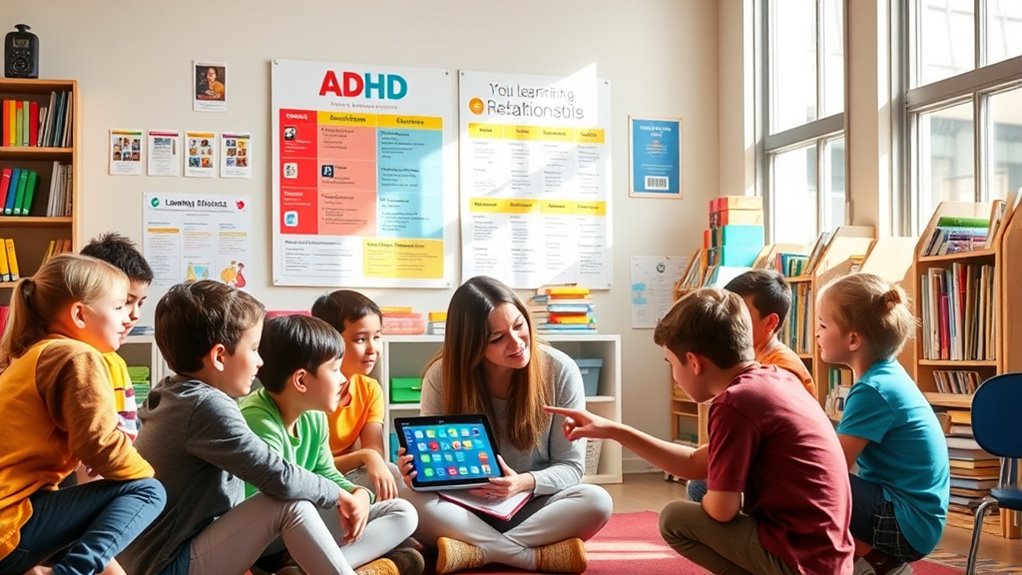If you’re supporting a child with ADHD, it’s essential to understand how it impacts their learning and social interactions. Many kids with ADHD also face comorbid learning disabilities, which complicates things even more. You can implement effective strategies like structured routines, personalized instruction, and technology aids to boost their learning experience. Being aware of educational policies and accessing available resources can greatly help. Let’s explore more ways you can support their journey to success.
Key Takeaways
- Customized support strategies, such as structured routines and clear expectations, improve learning experiences for students with ADHD and learning differences.
- Utilizing technology tools like talk-to-text software and visual aids enhances organization and retention for students with ADHD.
- Mindfulness practices can help manage emotional challenges and improve focus for children with ADHD and learning disabilities.
- Collaboration with teachers and peers fosters social skills and enhances the educational experience for children with ADHD.
- Familiarity with educational policies like IDEA and Section 504 empowers parents to advocate for necessary accommodations and support.
Understanding ADHD and Its Impact on Learning

Understanding ADHD and its impact on learning is essential, especially since many students struggle to thrive in traditional classroom settings. ADHD symptoms, like attention challenges, can cause you to miss key concepts during lessons. Hyperactivity and impulsivity may lead to fidgeting or interrupting others, disrupting both your learning and that of your peers. Additionally, executive functioning issues affect your planning and organization, making task completion difficult. These challenges can lower your academic performance and lead to feelings of frustration and inadequacy. Distractions in the classroom further complicate your ability to focus, while social interactions may suffer due to impulsive behaviors. Recognizing these effects helps in developing tailored strategies to support your learning experience. Furthermore, the prevalence of ADHD diagnoses has increased significantly, highlighting the need for better understanding and support for affected students. Many students with ADHD also experience emotional neglect from peers or family, which can further impact their self-worth and identity. Implementing personalized learning pathways can significantly enhance engagement and outcomes for students with ADHD. Moreover, fostering self-awareness through mindfulness practices can empower students to effectively manage their symptoms and improve their overall learning experience. Additionally, using goal setting techniques can help students stay focused on their academic objectives and create a sense of achievement. Establishing consistent routines can provide the structure necessary for students with ADHD to thrive.
Recognizing Comorbid Learning Disabilities

Many students with ADHD face additional hurdles due to comorbid learning disabilities. Around 45% to 50% of children with ADHD also deal with conditions like dyslexia, dyscalculia, or dysgraphia. The rates of comorbidity can vary considerably, ranging from 10% to 92%, depending on the study. This overlap complicates academic functioning, leading to challenges in reading, writing, and math. ADHD symptoms can lead to challenges in concentration and retention, further exacerbating learning difficulties. Engaging in mindfulness practices can help mitigate some of these challenges. Additionally, understanding the importance of clear communication in educational settings can foster better relationships between students and educators. Development influenced by biological factors can also play a role in how these disabilities manifest. Financial considerations for assisted living expenses can also impact families supporting children with ADHD and learning differences, as navigating educational needs may require additional resources. Regularly checking and cleaning air purifier filters can create a healthier learning environment, which may positively influence focus and academic performance.
Executive functioning issues can arise, making organization and time management difficult. Recognizing these comorbidities is essential for effective support. A thorough assessment by professionals is vital to identify coexisting conditions accurately. By distinguishing between ADHD symptoms and learning disabilities, you can receive tailored interventions that address both sets of challenges, ultimately improving your academic experience.
Overcoming Educational Challenges

While traversing the classroom can be challenging for students with ADHD, effective strategies can greatly enhance their educational experience. You might struggle with distractions and find it tough to complete tasks due to impulsivity and organization issues. This can lead to frustration and a negative self-image.
However, customized solutions can help you thrive. Teachers can implement structured environments with clear expectations and use multimodal learning methods to keep you engaged. Allowing quiet fidget activities can also improve focus. Additionally, frequent breaks in attention can be managed with targeted strategies to help maintain concentration. Incorporating technology tools like talk-to-text software can aid in note-taking and organization. Furthermore, open communication about feelings can help students express their frustrations and seek assistance when needed, creating a supportive classroom environment. Moreover, pet therapy can also provide emotional support and improve focus, helping to create a positive learning environment. Utilizing smart shopping strategies can also empower students to find resources and tools that enhance their learning experience. Importantly, seeking professional advice can lead to tailored strategies that address individual learning needs. Remember, collaboration with teachers and peers can foster interpersonal skills, making your learning journey more enjoyable and successful.
Implementing Effective Support Strategies

Maneuvering the classroom can be made easier with the right support strategies tailored for students with ADHD. Start by establishing predictable routines to create stability. Deliver instructions one at a time, using visual aids like charts to enhance understanding. Minimize distractions by reducing background noise and visual clutter. Incorporating emotional regulation techniques can also help students manage their responses to frustration and maintain focus. Engaging in continuous learning through professional development for educators can elevate the effectiveness of these strategies. Integrate technology through interactive tools that engage students and support their learning. Encouraging multisensory learning by incorporating visual aids, tactile activities, and movement breaks can enhance retention and engagement. Use planners and visual timers to foster time management, breaking tasks into manageable chunks. Personalizing instruction and incorporating games can boost motivation. Additionally, regular veterinary check-ups for pets can teach students about responsibility and care, enhancing their emotional well-being. Finally, create a safe learning environment that emphasizes positive reinforcement, helping students thrive. These strategies empower students with ADHD to navigate their educational journey successfully. Additionally, implementing structured routines can significantly aid in managing attention and impulsivity. Furthermore, utilizing gentle stretching techniques before class can enhance focus and reduce tension, creating a more conducive learning environment. Recognizing soulmate angel numbers can also inspire students to build deeper connections and support one another emotionally.
Navigating Policies and Access to Resources

Maneuvering the complexities of educational policies and access to resources can feel overwhelming, especially when you’re advocating for a child with ADHD. Understanding laws like IDEA and Section 504 is vital; they guarantee your child receives appropriate accommodations. The divorce process can also create additional challenges for families navigating these issues.
IDEA focuses on specialized education tailored to individual needs, while Section 504 emphasizes equal access through environmental adjustments. ADHD is often linked with anxiety and overthinking, which can further complicate the learning experience for your child. Additionally, financial implications from divorce may impact your ability to access necessary educational resources and support. Establishing a clear financial settlement time limit can help alleviate some of the stress associated with these challenges. Embracing sustainable living practices can provide a supportive environment that nurtures your child’s learning journey. Moreover, understanding the legal protections available can empower you to advocate effectively for your child’s needs.
Organizations like CHADD and the National Resource Center on ADHD offer valuable resources for families. You can access tools for organization and time management, which are fundamental for success.
Frequently Asked Questions
What Are the Signs of ADHD in Preschoolers?
When you’re observing preschoolers, watch for signs like hyperactivity, where they can’t sit still, or inattentiveness, losing interest quickly.
You might notice impulsive behaviors, such as interrupting conversations or talking excessively.
Emotional regulation issues can lead to tantrums, and motor skill difficulties might show up as trouble hopping on one foot.
If they struggle with self-control and often get into accidents, these could also be indicators of ADHD.
How Can Parents Advocate for Their Child’S Needs at School?
Picture your child standing at the school gates, eyes wide with hope. You can advocate for their needs by building strong relationships with teachers, sharing your child’s unique strengths and challenges.
Attend meetings, ask questions, and guarantee they understand your child’s learning style. Collaborate on strategies that work best, like extra time on tests or specific resources.
Are There Specific Diets That Help Manage ADHD Symptoms?
Yes, specific diets can help manage ADHD symptoms. You might want to focus on balanced nutrition with whole foods like fruits, vegetables, and lean proteins.
Reducing processed foods and sugar can also be beneficial. Some evidence suggests that omega-3 fatty acids, vitamin D, and certain minerals like zinc and iron can improve focus.
Tailoring your diet based on individual sensitivities can further support symptom management. Consulting a healthcare professional before making changes is essential.
What Role Does Medication Play in Treating ADHD?
Imagine you’re a college student struggling to focus during lectures. Medication can play a vital role in treating ADHD by helping you sharpen your attention and manage impulsivity.
Stimulants like methylphenidate often enhance your concentration, leading to improved academic performance. However, it’s important to evaluate potential side effects and discuss options with your healthcare provider.
Combining medication with behavioral strategies can boost your success even further, making it a thorough approach to treatment.
How Can Parents Find Support Groups for ADHD?
To find support groups for ADHD, start by searching online for local chapters of organizations like CHADD or the Learning Disabilities Association of America.
You can also explore Facebook for private groups where parents share experiences.
Consider joining virtual support groups through platforms like ADDA, which provide a welcoming environment.
Don’t hesitate to check community centers or libraries for local events.
Connecting with others can make a significant difference in your journey.
Conclusion
In summary, understanding ADHD and its impact on learning can empower you to seek the right support for yourself or your child. Did you know that nearly 40% of children with ADHD also have a learning disability? By recognizing these challenges and implementing effective strategies, you can overcome obstacles and unleash potential. Don’t hesitate to navigate available resources and advocate for the support you deserve, because every step you take can lead to significant progress.









